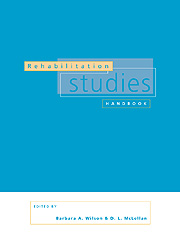Book contents
- Frontmatter
- Contents
- List of contributors
- 1 Introduction to rehabilitation
- 2 Disabled people in society
- 3 Disability equality training
- 4 Towards a therapeutic alliance model of rehabilitation
- 5 Rehabilitation education: a learner-centred approach
- 6 Work, occupation and disability
- 7 Management in rehabilitation
- 8 Research and evaluation in rehabilitation
- 9 Statistical methods
- 10 Social policy, disability and rehabilitation
- 11 Principles of the acquisition of sensorimotor skills
- 12 Management of acquired cognitive disorders
- 13 Challenging behaviour: helping people with severe brain damage
- 14 Pain
- 15 The multiply handicapped child
- 16 The transition to adult life
- 17 Factors specific to disabled elderly people
- Index
1 - Introduction to rehabilitation
Published online by Cambridge University Press: 06 November 2009
- Frontmatter
- Contents
- List of contributors
- 1 Introduction to rehabilitation
- 2 Disabled people in society
- 3 Disability equality training
- 4 Towards a therapeutic alliance model of rehabilitation
- 5 Rehabilitation education: a learner-centred approach
- 6 Work, occupation and disability
- 7 Management in rehabilitation
- 8 Research and evaluation in rehabilitation
- 9 Statistical methods
- 10 Social policy, disability and rehabilitation
- 11 Principles of the acquisition of sensorimotor skills
- 12 Management of acquired cognitive disorders
- 13 Challenging behaviour: helping people with severe brain damage
- 14 Pain
- 15 The multiply handicapped child
- 16 The transition to adult life
- 17 Factors specific to disabled elderly people
- Index
Summary
This chapter reviews some of the basic factors that determine the direction and effectiveness of rehabilitation and which are important for its scientific development. Many of the issues touched on here are dealt with in greater depth later in the handbook.
The word ‘rehabilitation’ can be applied to many things: crumbling buildings, disgraced politicians, convicted burglars, frail old ladies and soldiers injured in battle. This book is about the type of rehabilitation that people with biological impairments and disabilities often seek to achieve in order to attain the kind of lifestyle of their choice. It discusses some of the approaches used both by them and the various rehabilitation professions which help bring this about. This inevitably requires an understanding of the cultural and physical environment in which disabled people are living.
Rehabilitation can be defined in two quite different ways.
A process of active change by which a person who has become disabled acquires the knowledge and skills needed for optimal physical, psychological and social function.
The application of all measures aimed at reducing the impact of disabling and handicapping conditions and enabling disabled and handicapped people to achieve social integration.
The first definition recognises that rehabilitation involves a personal journey in which the disabled person not only has to choose the destination and the route taken, but also to do most of the work. This process is much closer to education and training than to medical treatment with drugs or surgery.
The primary purpose of medicine is to relieve suffering caused by disease.
- Type
- Chapter
- Information
- Rehabilitation Studies Handbook , pp. 1 - 20Publisher: Cambridge University PressPrint publication year: 1997
- 14
- Cited by



